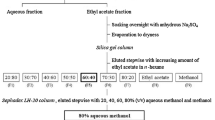Abstract
In order to evaluate the allelopathic potential of Nepeta meyeri Benth., the effects of aqueous extracts (0.125, 0.25, 0.5, 1, 2.5 and 5%) prepared from roots and leaves of N. meyeri were studied on the seed germination and seedling growth of several economically important crops (barley, wheat, canola, safflower, and sunflower). Both the root and leaf extracts of N. meyeri caused a general phytotoxic effect on the seed germination and seedling growth of barley and sunflower at all concentrations. However, both the root and leaf extracts significantly increased the seedling growth of wheat, especially at the lower concentrations 0.125, 0.25 and 0.5%, whereas the higher concentrations had a neutral effect. The seed germination and the seedling growth of canola and safflower were also generally improved by both extracts, especially at lower concentrations. However, these advantages were not observed at higher concentrations, at which the extracts mostly had a phytotoxic effect on canola and safflower. The Allelopathic activity of N. meyeri depended on whether the extract was derived from the leaf or root parts of the plant. The maximum allelopathic effect occurred with leaf extracts. The results demonstrate that the aqueous extracts from N. meyeri have allelopathic potential and should be evaluated as an allelopathic species, presenting a risk or advantage to seed germination and seedling growth of crop or weed plants.



Similar content being viewed by others
References
Aytac Z, Yildiz G (1996) A new record for the Flora of Turkey. Turk J Bot 20:385–386
Baser KHC, Demircakmak B, Duman H (1998) Composition of the essential oils of Nepeta sulfuriflora P·H. Davis. J Essent Oil Res 10:179–181
Bourrel C, Perineau F, Michel G, Bessiere JM (1993) Catnip (Nepeta cataria L.) essential oil: analysis of chemical constituents, bacteriostatic and fungistatic properties. J Essent Oil Res 5:159–167
Çalmaşur O, Aslan I, Sahin F (2006) Insecticidal and acaricidal effect of three Lamiaceae plant essential oils against Tetranychus urticae Koch and Bemisia tabaci Genn. Ind Crops Prod 23:140–146. doi:10.1016/j.indcrop.2005.05.003
Dabiri M, Sefidkon F (2003) Chemical composition of the essential oil of Nepeta racemosa Lam. from Iran. Flavour Fragr J 18:157–158. doi:10.1002/ffj.1151
Dapkevicius A, Venskutonis R, van Beek R, Linssen JPH (1998) Antioxidant activity of extracts obtained by different isolation procedures from some aromatic herbs grown in Lithuania. J Sci Food Agric 77:140–146. doi :10.1002/(SICI)1097-0010(199805)77:1<140::AID-JSFA18>3.0.CO;2-K
Dirmenci T (2005) A new subspecies of Nepeta (Lamiaceae) from Turkey. Bot J Linn Soc 147:229–233. doi:10.1111/j.1095-8339.2005.00355.x
Esmaeili A, Rustaiyan A, Masoudi S, Nadji K (2006) Composition of the essential oils of Mentha aquatica L. and Nepeta meyeri Benth. from Iran. J Essent Oil Res 18:263–265
Inderjit Callaway RS (2003) Experimental designs for the study of allelopathy. Plant Soil 256:1–11
Jefferson LV, Pennacchio M (2003) Allelopathic effects of foliage extracts from four Chenopodiaceae species on seed germination. J Arid Environ 55:275–285. doi:10.1016/S0140-1963(03)00028-4
Macias FA, Oliva RM, Varela M, Torres A, Molinillo MG (1999) Allelochemicals from sunflower leaves cv. Peredovick. Phytochemistry 52:613–621. doi:10.1016/S0031-9422(99)00141-7
Narwal SS (1999) Allelopathy update, basic and applied aspects, vol 2. Science Publishers Inc., New Hampshire, pp 200–254
Noguchi HK, Ino T (2005) Possible involvement of momilactone B in rice allelopathy. J Plant Physiol 162:718–721. doi:10.1016/j.jplph.2004.11.009
Nojavan AM (1990) An Investigation of allelopathic effects of catnip (Nepeta meyeri L.) on seed germination and seedling growth of wheat and radish. Res J Esphahan Univ Fall
Nostro A, Cannatelli MA, Crisafi G, Alonzo V (2001) The effect of Nepeta cataria extract on enzyme production of Staphylococcus aureus. Int J Antimicrob Agents 18:583–585. doi:10.1016/S0924-8579(01)00452-6
Om H, Dhiman SD, Kumar S, Kumar H (2002) Allelopathic response of Phalaris minor to crop and weed plants in rice–wheat system. Crop Prot 21:669–705. doi:10.1016/S0261-2194(02)00025-X
Oueslati O (2003) Allelopathy in two durum wheat (Triticum durum L.) varieties. Agric Ecosyst Environ 96:161–163
Sajjadi SE, Khatamsaz M (2001) Volatile constituents of Nepeta heliotropifolia Lam. J Essen Oil Res 13:204–205
Sefidkon F, Shaabani A (2004) Essential oil composition from Nepeta meyeri Benth from Iran. Flavour Fragr J 19:236–238. doi:10.1002/ffj.1294
Singh HP, Batish DR, Kohli RK (2003) Allelopathic ınteractions and allelochemicals: new possibilities for sustainable weed management. Crit Rev Plant Sci 22:239–311. doi:10.1080/713610858
Suman A, Shahi HN, Singh P, Guar A (2002) Allelopathic influence of Vigna mungo (black gram) seeds on germination and radical growth of some crop plants. Plant Growth Regul 38:69–74. doi:10.1023/A:1020943011207
Tefera T (2002) Allelopathic effects of Parthenium hysterophorus extracts on seed germination and seedling growth of Eragrostis tef. J Agron Crop Sci 188:306–310. doi:10.1046/j.1439-037X.2002.00564.x
Weston LA, Duke SO (2003) Weed and crop allelopathy. Crit Rev Plant Sci 22:367–389. doi:10.1080/713610861
Wu L, Guo X, Harivandi MA (1998) Allelopathic effects of phenolic acids detected in buffalograss (Buchloe dactyloides) clippings on growth of annual bluegrass (Poa annua) and buffalograss seedlings. Environ Exp Bot 39:159–167. doi:10.1016/S0098-8472(97)00040-3
Wu H, Haig T, Pratley J, Lemerle D, An M (2000) Distribution and exudation of allelochemicals in wheat Triticum aestivum. J Chem Ecol 26:2141–2154. doi:10.1023/A:1005520500110
Yu JQ, Ye SF, Zhang MF, Hu WH (2003) Effects of root exudates and aqueous root extracts cucumber (Cucumis sativus) and allelochemicals, on photosynthesis and antioxidant enzymes in cucumber. Biochem Syst Ecol 31:129–139. doi:10.1016/S0305-1978(02)00150-3
Acknowledgments
This work has been supported by grant from Atatürk University Research Fund, No: BAP-2005/171.
Author information
Authors and Affiliations
Corresponding author
Additional information
Communicated by F. Corbineau.
Rights and permissions
About this article
Cite this article
Mutlu, S., Atici, Ö. Allelopathic effect of Nepeta meyeri Benth. extracts on seed germination and seedling growth of some crop plants. Acta Physiol Plant 31, 89–93 (2009). https://doi.org/10.1007/s11738-008-0204-0
Received:
Revised:
Accepted:
Published:
Issue Date:
DOI: https://doi.org/10.1007/s11738-008-0204-0



